Is your snake plant turning yellow? Are you wondering why this is happening and how can you fix it? Let’s explore the causes of this issue and how you can diagnose it!
Snake plants are evergreen plants that grow straight upright and are very popular for their attractive appearance. Sometimes for some reason your Snake plant may turn yellow.
Don’t worry, this issue is very common and happened to me too when I brought a snake plant home for the first time. And don’t be afraid, because it is not going to die and you still have time to fix it.
Snake plants turn yellow when you ignore the plant or over-care for your plant. Also, sometimes these plants get affected by some diseases, although you are providing proper care to them. So, today in this article, I will have a little chat with you about the reason behind a snake plant turning yellow, and how to fix this issue.
Why is my snake plant turning yellow?

Usually, the mature Snake Plant are dark green. But, sometimes these plants may turn yellow. The edges of the leaves of some snake plants might be yellow color naturally, but if the complete leaf (or leaves) are turning yellow, then it is time for you to pay attention to your plant to save it. In this case, your plant is probably telling you that it is not feeling well.
So, let us discuss the reasons behind the snake plant turning yellow to fix the problem!
1. Aging in the snake plants

Snake plants turn yellow when they become old. It is okay if the old leaves of the plant turn yellow and eventually fall off. But, your plant needs your attention if you observe more than 3-4 leaves turning yellow and a drop in the plant’s growth.
2. Watering the snake plants
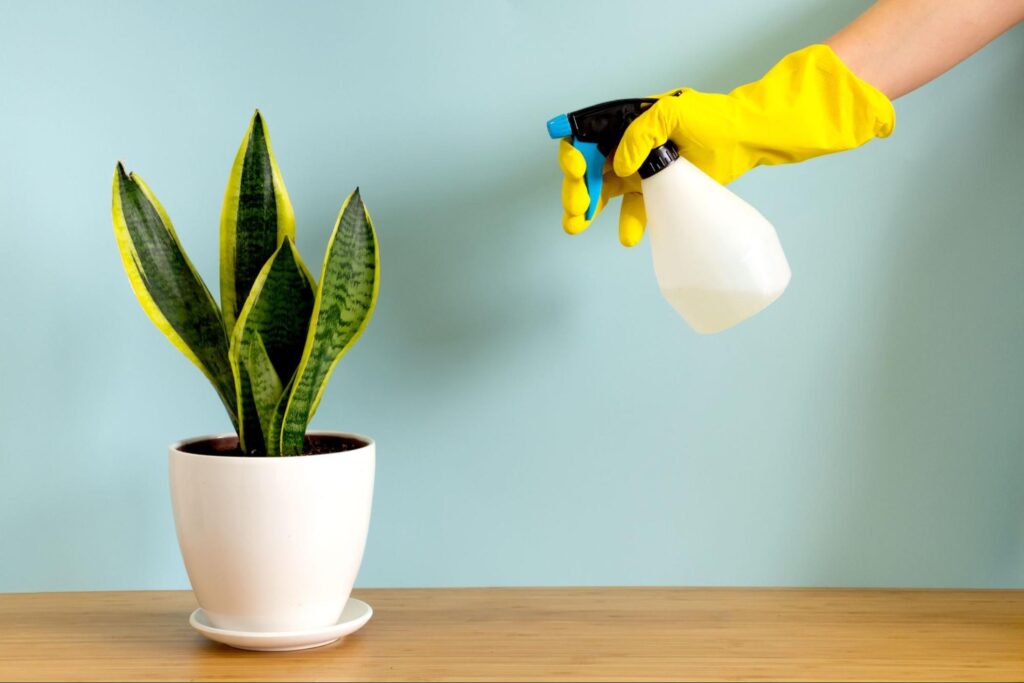
Like other plants, snake plants need water to survive, although they can tolerate drought conditions. But you need to provide the right amounts of water to the plant for its healthy growth. Otherwise, your snake plant will change its color. Now, let us discuss how incorrect watering habits will trouble the plant.
Overwatering the snake plants
Snake plants do not need much water to survive. These plants are succulents that absorb the water and store them in the plant cells to use whenever it is needed. Watering it often or providing more water at a time may lead to overwatering. In this case, the roots get in contact with water for a long time and get rotten. This rotten rot cannot function properly and may lead to discoloration of the leaves.
Due to overwatering, the roots absorb more water and store them in the plant cells, which makes the leaves mushy and thus change their color to yellow. If you still ignore the plant, the yellow leaves become droopy and eventually fall off and the root rot may completely spoil the plant.
Underwatering the snake plants
The other side of improper watering is underwatering. This will also affect the plant’s growth and lead to the yellowing of leaves. Most people think that succulents do not need much water to thrive and often delay watering the snake plants or provide less amount of water to them.
This leads to dehydration in the plant. Snake plants need a full drink of water to fill the plant cells but less frequently. Under watering may dry the plant, so the leaves of the plant get curled and may turn yellow and gradually fall off. It may take a long time to recover the plant from the loss.
3. Fungal infections occurring in the snake plants
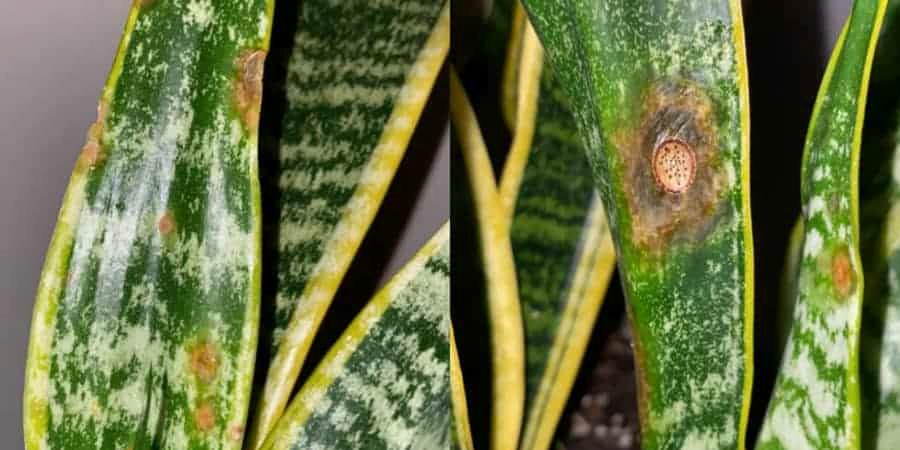
Fungal infections are majorly caused by overwatering, improper soil mixes, or pots that do not allow aeration into the soil. Fungi like pythium and fusarium that are born in the waterlogged soil, may cause root rots, suck the nutrients present in the soil, absorb the water in the soil and the damaged roots cannot absorb enough oxygen and fail to function properly. Thus they damage the plant and turn the Snake plant yellow.
If fungus grows in the soil then it shows a sign of mold growth on the surface of the soil and even on the foliage of the plant when you neglect it for some time. In this case, the soil mix may emit a foul smell.
4. Sunlight as a reason

We all know that sunlight plays a crucial role in the plant’s survival. But if the plant does not get adequate sunlight then they change its color to yellow. We can observe the plant turning yellow in two cases. One is the plant does not get enough sunlight and the other is the plant is overexposed to the sun. Now, let us know how the plant gets affected in both cases.
Lack of Sunlight
Sunlight is responsible for the process of photosynthesis in the plant. Lack of sunlight leads to yellowing in snake plants. Being succulent, snake plants need enough sunlight to thrive. They love to be in bright indirect sunlight. Placing the plant in dark rooms or a place that does not get enough light often results in discoloration of the plant.
Overexposure to sun
Overexposure to the sunlight will also turn the snake plant yellow. Snake plants need bright light to survive, but they cannot tolerate being in direct sunlight for a long time. The intense sun rays will damage the foliage by causing sunburns and discoloration. Also, overexposure to the sun may result in dehydration in the plant which turns the plant yellow and finally leads to leaf-drop.
5. How fertilization can be an issue

Fertilization can be a real issue if you overfertilize or under-fertilize your snake plants. Let’s now find out how over-fertilization and under-fertilization can turn your dear snake plants yellow!
Over fertilization of the snake plants
Generally, snake plants do not need fertilization for their survival. But, fertilization helps in boosting the growth of the plant. So, most beginners fertilize their snake plant often to increase the growth rate. This leads to yellowing in the plant as the roots of the snake plants get damaged or burned due to over-fertilization.
Also, concentrated fertilizers affect the plant as over-fertilization does, even if you do not fertilize it often. Fertilizing once or twice a year helps the plant in better growth and more than that may turn your plant yellow.
Under fertilization of the snake plants
Even though the snake plants do not need fertilization soon after repotting or newly potted, you should feed the plant after some months, as the nutrients present in the soil mix may get exhausted and may make the plant nutrient less which further turns the plant yellow. Using mild fertilizers to feed during the growing season will prevent this problem and also encourage growth.
6. Compact Soil mix for the snake plants

Being a succulent, the snake plant needs to be planted in well-draining soil mixes. Compact soils hold the water for a long time, which is not a suitable condition that makes the snake plant turning yellow. The excess water after fulfilling the soil and the roots should come out through the drainage holes.
But in the case of compact soil mix, it holds the excess water and becomes waterlogged. This makes the roots absorb more water than they need and thus leads to overwatering-related issues, even if you provide a minimum quantity of water. By absorbing more water the leaf cells become soggy and turn yellow.
7. Material and size of the pot of the snake plants

Even the pots that are used to plant the snake plant will have a significant effect in turning the plant yellow. Because the pots made of plastic and other such materials will not help the soil to dry quickly. Aeration through the walls of the pot may not be possible. When we take unglazed ceramic pots, unfinished terracotta pots or clay pots will help the soil that is in contact with the walls to dry quickly and allow the passage of the air through their porous walls.
These plants do not like to stay in waterlogged soil for a long time. So, it is better to pot them in pots that are 1-2 inches larger than the root system of the plant. Because, if the pots which are filled with soil mix are too large for the root system, it holds water for a long time leading to root rot which results in the yellowing of the plant.
8. Deficiency of iron in the snake plants
Your snake plant turns yellow if there is an iron deficiency in the plant cells but we observe this case very rarely. Snake plants turn yellow due to an imbalance of the minerals in the plant cells. Iron and other such minerals, if deficient, are responsible for the discolor of the plant turning it yellow.
The soil mix which contains all these essential minerals gets futile after some time and cannot supply these minerals to the plant through the water. This affects chlorosis and results in the loss of green pigment. Thus, the leaves of your plant change their color turning yellow.
9. The temperature of the snake plants
Snake plants love to be in moderate temperatures. The suitable temperature range of the plant is 60-80 degrees Fahrenheit. Having succulent qualities they can tolerate little high temperatures up to 90 degrees Fahrenheit, but temperatures below 45 degrees Fahrenheit will turn the plant yellow.
These Snake plants thrive well at room temperatures and slightly above. The temperatures below this range for a long period will lead to stress in the plant and thus lead to yellowing of the plant. Also, temperatures above the suitable range can cause dehydration in the plant and can be harmful. So, it is necessary to maintain your snake plant at suitable temperatures.
10. Improper drainage of the snake plants
If the pot of your Snake plants does not have a proper drainage system, then the soil holds the water, which should be drained and your plant may not like this. Snake plants are succulents and do not like to stay in waterlogged soil for a long time. The roots of these plants get rotten if they are in contact with the water. Turning yellow is one of the signs of a root rotten plant. You need to respond to it and provide enough care to save it from death.
11. Pests that attack the snake plants
These hardy snake plants might get affected by some sap-sucking pests like scale, mealybug, spider mites, aphids, and thrips. These pests such as the watery sap are present in the leaves of the snake plants. This leads to the drying of the foliage which gradually turns yellow and finally drops.
How can you save a yellow snake plant?
I know saving a snake plant is very important for you because it is such a dear and beautiful plant. I just can’t see it suffer, can you? That is why let us discuss some tips that you must know to save your beloved yellow snake plant.
1. Water the snake plants whenever it needs
It is better to check the moisture of the soil before watering, rather than following a schedule. Because the dryness of the soil depends on the climatic conditions. You can use a moisture meter to check the soil moisture or simply dip your finger in the soil at a one-inch depth.
Water the plant only if the soil is completely dry. Do not water it if you feel that the soil is wet inside. Whenever you water your plant, water it until the excess water comes out of the drainage holes. Also, remember to water it slowly to let the complete soil mix and root system absorb the water.
2. Providing enough Sunlight to the snake plants
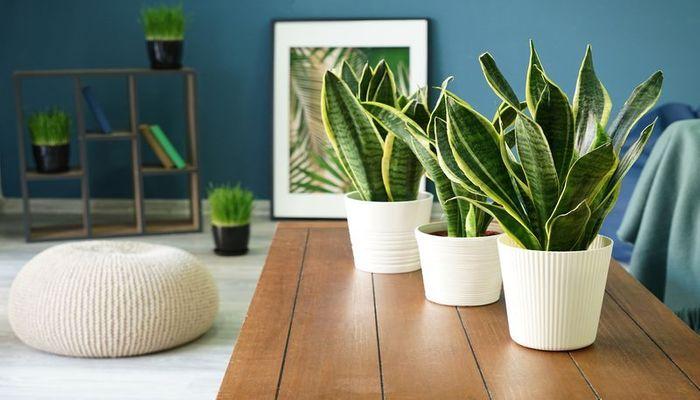
Your Snake plant needs enough sunlight to thrive. Place your plant in an area that gets bright light. Provide at least six hours of indirect sunlight to the plant that helps in photosynthesis. Sunlight also helps the plant in the production of carbohydrates which are further converted into energy. But avoid placing your plant in direct sunlight. Make sure to close the windows near the plant during the afternoons to avoid the effect of direct sun. You can use drapes to cover the windows to avoid the passage of direct sun rays through the window glass.
3. Repotting your snake plant regularly
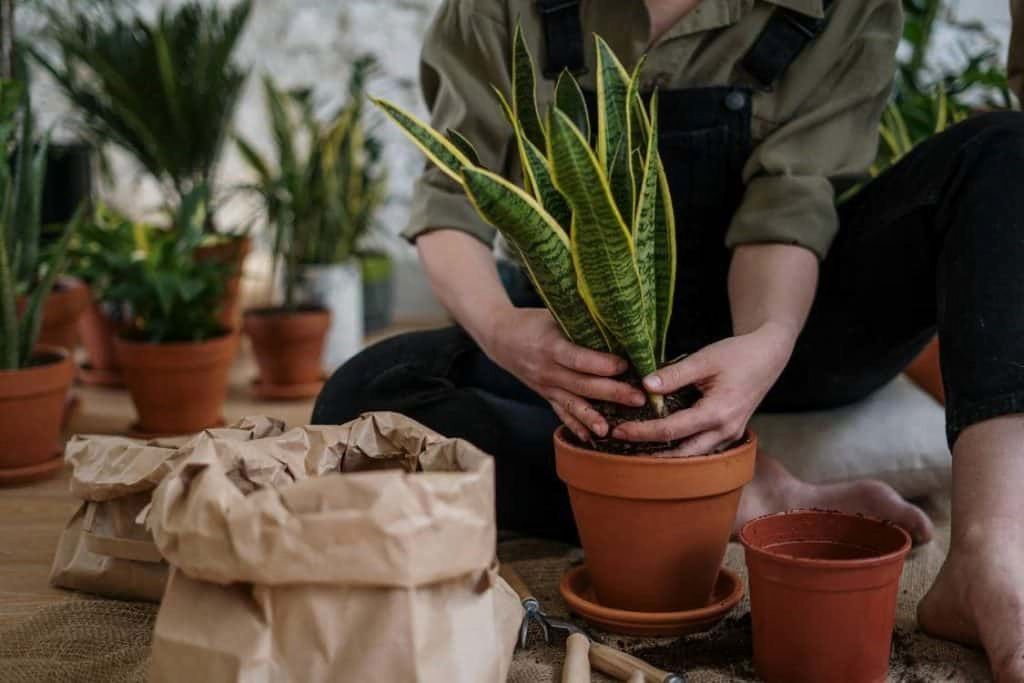
Your plant needs to be repotted every year or at least once in 1-2 years to maintain the plant’s health. Repotting helps to supply enough nutrients to the plant which prevents the lack of nutrition and avoids a discoloration of the plant. Repot your plant with suitable pots that are made up of clay to allow aeration into the soil. Also, use a suitable potting mix to plant your Snake plant.
4. Maintaining suitable temperatures around snake plants
Snake plants love to stay at room temperatures. The suitable range of temperatures of snake plants is between 60 and 80 degrees Fahrenheit. Avoid placing the plant on window sills during the hot summer and on the nights of cold winter. Remember the temperature above and below the range will surely damage the plant. If the temperature falls too low then you need to use plant heaters to maintain the temperature.
5. Using cactus mix for the snake plant
Using cactus mix or the succulent mix works well in the case of these snake plants. Cactus mix has the quality of well-draining and it does not hold the water after fulfilling the roots of the plant and dries quickly. Thus, it helps the roots to absorb enough oxygen and function properly to prevent root rot and fungal growth which does not allow the plant to turn yellow. You can also prepare a well-draining soil mix at home by mixing soil, coarse sand, and perlite in a 2:1:1 ratio respectively.
6. Using fungicides for the snake plant
We have discussed that the fungal growth in the soil can damage the roots. So, it is better to prevent fungal growth in the soil by controlling your watering schedule. If you observe the fungal growth in the soil mix then first use fungicides to treat the problem. If the growth is severe and the soil is emitting a foul smell, (you may suspect root rot in this case) then it is better to take the plant out of the pot and change the soil, cut the damaged parts of the root system if any and sterilize the pot before placing the plant again or, you can even change the pot. This will help the plant to regain its health.
7. Removing pests that can occur to the snake plants
Pest growth is another problem that turns your plant yellow. Observe your snake plant and if you find any pests that are lying on the leaves, gently pick them and throw them out. If they are minute and you cannot hold them or even see them clearly, then spray pesticides. You can also treat the pests by applying neem oil to the foliage or taking a cotton ball, dipping it in the rubbing alcohol, and wiping the infected parts. Spraying water mixed with mild soap can also treat the pests on your snake plant.
8. Provide enough feeding to the snake plants
Fertilize the Snake plant once or twice in the growing season to encourage its growth. But do not fertilize it more or often. Also do not use concentrated fertilizer to feed the snake plant. Use mild liquid fertilizers or dilute the concentrated fertilizers to feed your plant. Do not fertilize your plant in winters as the plant slows down growth at a low temperature. So fertilizing during that time can cause stress in the plant which can turn the plant yellow. Only fertilize it once or twice during the growing season.
9. Provide a proper drainage system for the snake plants
Providing a proper drainage system will secure the plant from bothering diseases. Make sure that the pot you have selected to plant your snake plant has a good number of drainage holes. Use gravel to fill the bottom layer of the pot to avoid drainage holes from clogging.
FAQ’s
Q1. Is yellowing natural in snake plants?
Ans. Yes, it is natural to some extent. The leaves of some species of the snake plants have yellow borders and little patches, it is quite natural. As we discussed that aging may cause yellowing in snake plants, you can consider that as a natural cause. Other than aging there are no probable natural causes of yellowing in Snake plants.
Q2. Is it necessary to remove yellow leaves from the plant?
Ans. You can leave the leaves to fall off until it does not cause any harm to the plant. It is better to cut the yellow leaves carefully if they are badly affected by fungus or pests. It avoids the spread of the infection. Also, removing the yellow leaves will help the plant share its energy among the healthy parts of the plant. But make sure you prevent the yellowing of the plant in the future.
Q3. Should I remove my yellow snake plant?
Ans. No, you do not need to remove it. Find out the reason for the problem and try to solve it. Provide proper care and wait for its recovery. Your snake plant will regain its health. If the foliage of your snake plant is badly affected by fungal growth and if you think it cannot be recovered then you need to remove the plant.
Q4. Can yellow leaves turn green again?
Ans. You can recover the yellow leaves of your snake plant only in some cases. The recovery depends on the reason and severity of the damage. The slight discoloration of the leaves can be recovered but if the leaf of your snake plant turns yellow completely, it cannot be recovered. Yellow leaves of the snake plants which have changed their color due to lack of nutrition may turn green if they get enough nutrition.
Conclusion
Now, you know that multiple reasons can turn your beloved snake plants into yellow. If you figure out the exact reason for this issue, then with the help of our article, I am damn sure you can fix this issue on your own.
Let’s take a quick recap of the 11 reasons for your snake plant turning yellow:
- Aging in the snake plants
- Watering the snake plants
- Fungal infections occurring in the snake plants
- Sunlight as a reason
- How fertilization can be an issue
- Compact Soil mix for the snake plants
- Material and size of the pot of the snake plants
- Deficiency of iron in the snake plants
- The temperature of the snake plants
- Improper drainage of the snake plants
- Pests that attack the snake plants
Snake plants are beautiful and hardy plants that can be maintained with low care. Sometimes these tough plants may turn yellow due to these reasons. You can help your plant by saving it. Keep loving your plant and help it to thrive.
I hope you like this article as I tried my best to put forward all of the information that I could find with my knowledge and personal experience. I hope you find it helpful and informative, and if you have any further questions in your mind regarding the snake plant turning yellow, please feel free to comment down below, and don’t forget to share this article with your friends and family!


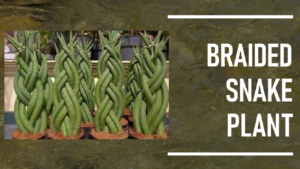





I really appreciate this post. I¦ve been looking all over for this! Thank goodness I found it on Bing. You’ve made my day! Thank you again
Thank you for reading our blog. We are glad you enjoyed it 😍